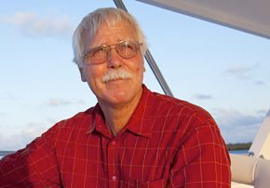
While the East Coast was digging out from one snowstorm after another this winter, the West Coast was digging in for another year of severe drought.
Some in the California marine industry are feeling the pain and facing an uncertain future. Others say the drought is something Californians are used to: Adjust and move on.
Hopes for relief ran high during a wet December, but concern began building in January — historically California’s wettest month — when the snow all but disappeared from the Sierra Nevada. Late March measurements of the Sierra snowpack came in at historic lows, and on April 1 Gov. Jerry Brown announced unprecedented mandatory statewide water restrictions.
“California’s water supplies continue to be severely depleted … with record-low snowpack in the Sierra Nevada mountains, decreased water levels in most reservoirs, reduced flow in the state’s rivers and shrinking supplies in the underground water basins,” Brown said.
Dave Geoffroy, vice president of the National Marine Manufacturers Association West (formerly the Marine Trades Association of Southern California), which covers California, Nevada and Arizona, says Brown’s water mandates have reignited the focus on the drought.
“This is nothing new to us,” says Geoffroy. “This has been going on for several years. The coastal marinas are fine, and those in the Delta area, which is fed by the bay, are also doing well. But it has been devastating for some inland lakes in the middle of the state.”

Geoffroy says it would have been irresponsible for Brown not to have made “some sort of concentrated effort” to reduce water use. But, he says, the drought “certainly does not mean people are stopping their boating — they are just finding different places to go boating. Even with the drought, we have tremendous boating opportunities here in California, from the coastal bays and waterways to the rivers and the many lakes not affected by the water shortage.”
When the Sierra snowpack was measured on April 1, it was only a grim 5 percent of its normal April size — by far the lowest measure on record. The previous lowest April 1 measurement was 25 percent of normal size. The snowpack size has dropped for four years in a row, starting in 2012, and California is officially in its fourth year of drought.
In addition to the threat of marina closings, fish and wildlife are faced with potential rising salinity levels, advancing in from the sea.
The governor’s April 1 executive order calls on the state’s Department of Water Resources, if necessary, to implement emergency drought salinity barriers, in consultation with the Department of Fish and Wildlife, at locations in the Sacramento-San Joaquin Delta estuary. Among other things, the barriers may be necessary to raise water quality to levels that meet state and federal Endangered Species Act requirements in the delta.
Monterey County is one area in which years of continued drought have forced some marinas to close. In places such as the northern Salinas Valley, seawater invasion has reduced the quality of fresh water. In some areas of the county, fishing, camping and other lake activities have been restricted.

Diamond Valley Lake, halfway between Los Angeles and Palm Springs and the largest reservoir in Southern California, is another casualty of the drought, closed for recreational use because of low water levels.
“Lake San Antonio [in Monterey County] is indeed below the level which would accommodate a full resort operation,” says Mark Sandoval, general manager of Monterey Lakes Recreation Co., a division of the California Parks Co. “The North Shore, which offers lakeside camping, is completely closed. There is currently not a launch ramp capable of launching on the lake.”
But, says Sandoval, the lake’s South Shore rental units are open, as is camping. Nearby Lake Nacimiento is open and plans to operate a full resort season. “The stores and marina, with on-water fuel, are currently open every day,” says Sandoval. Lodging and camping and the launch ramp are open. The restaurant and pool will open in mid-May.
The Monterey County Parks Department determines when to close individual launch ramps.
The Metropolitan Water District of Southern California ordered the suspension of boat launch facilities on Diamond Valley Lake, the largest reservoir in Southern California, on April 15. The ramps at Diamond Valley Marina are high and dry, according to district spokesman Bob Muir, and the marina will be closed to recreational users. Diamond Valley Lake was at 48 percent capacity in early April, at the end of the rainy season and with the dry season fast approaching. Fishing along the shoreline, along with the use of approved canoes and kayaks, will still be allowed.
Brown’s water restrictions call for a statewide 25 percent reduction in potable water use (compared with amounts used in 2013) and the restrictions will be in place until Feb. 28, 2016.

Media outlets have found no shortage of drought images in Central California. Houseboats on Lake Kaweah sit below the high-water mark in Lemon Cove. Sections of Lake McClure in Coulterville are nearly dry. Waterlines have drawn away from high-water marks at Lake Cachuma in Santa Barbara, and dry docks can be seen in this area, which previously was under water.
The Central Valley has been hit hard by all accounts, but the governor emphasized that all parts of the state are facing drought conditions. Several cities in Northern California, including San Francisco, San Jose and Sacramento, were on track for their driest winter on record. According to National Weather Service reports, San Francisco received no rain in January — the first time this has happened in 165 years. January typically is the month of highest rainfall.
And it’s not just California. According to the U.S. Department of Agriculture’s National Water and Climate Center, many locations in the Cascades of Washington and Oregon, the Bitterroots of Idaho and Montana, and the Wasatch of Utah were either near or setting record-low snow-water equivalent values for early April. Automated sensors show below-average snowpacks in Colorado.
At the International Marina and Boatyard Conference in January, the Central Texas Water Coalition gave a presentation on low water levels in that state and their adverse effects on the marine industry.
As California works its way through this fourth year of drought, the State Water Resources Control Board is warning that water rights, including some held since before 1914, are likely to be curtailed in key watershed areas. Inland lakes and rivers could continue to see falling levels through the spring and summer, which would mean more marina closings. The state will make decisions in some cases, counties will decide on other marina closings, and some privately owned marinas may close their docks, too.
“Mother Nature decides,” says Sandoval, when asked who decides when the marinas and lakes close and what will happen next. “[Lake San Antonio’s] North Shore campgrounds are not open because there is no water there.”
He expects this to be the case for at least two to three more years.
Brown’s declaration comes with fines, required reporting from water districts and rate structures, and is armed with some teeth for enforcement. Commercial, industrial and institutional properties, such as golf courses, cemeteries and campuses, are required to immediately implement 25 percent water reductions.
The massive amount of water needed to maintain agricultural production across the state also has come under fire. Rice fields and almond groves, both of which require large amounts of water, have been targets of discontent. According to the Public Policy Institute of California, agriculture uses 80 percent of the water in California and accounts for 2 percent of the state’s economy.
Also under fire from environmentalists are animal agriculture and the oil industry’s use of hydraulic fracking. Although the government has placed some restrictions on agricultural water use, long-standing water rights muddy the reach of executive mandates.
This article originally appeared in the May 2015 issue.











